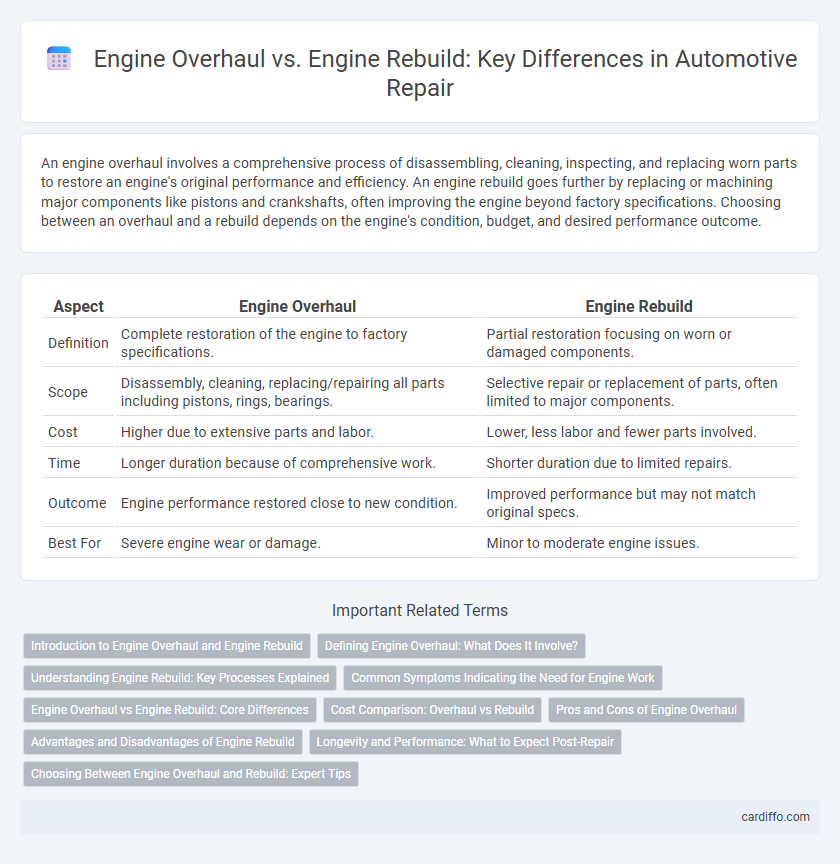An engine overhaul involves a comprehensive process of disassembling, cleaning, inspecting, and replacing worn parts to restore an engine's original performance and efficiency. An engine rebuild goes further by replacing or machining major components like pistons and crankshafts, often improving the engine beyond factory specifications. Choosing between an overhaul and a rebuild depends on the engine's condition, budget, and desired performance outcome.
Table of Comparison
| Aspect | Engine Overhaul | Engine Rebuild |
|---|---|---|
| Definition | Complete restoration of the engine to factory specifications. | Partial restoration focusing on worn or damaged components. |
| Scope | Disassembly, cleaning, replacing/repairing all parts including pistons, rings, bearings. | Selective repair or replacement of parts, often limited to major components. |
| Cost | Higher due to extensive parts and labor. | Lower, less labor and fewer parts involved. |
| Time | Longer duration because of comprehensive work. | Shorter duration due to limited repairs. |
| Outcome | Engine performance restored close to new condition. | Improved performance but may not match original specs. |
| Best For | Severe engine wear or damage. | Minor to moderate engine issues. |
Introduction to Engine Overhaul and Engine Rebuild
Engine overhaul and engine rebuild are comprehensive repair processes aimed at restoring an engine's performance and longevity. An engine overhaul involves inspecting, cleaning, and replacing worn components to bring the engine back to factory specifications, often including machining cylinder heads and replacing piston rings. In contrast, an engine rebuild typically entails a more extensive disassembly, replacement of major parts such as pistons, bearings, and gaskets, and reconditioning to effectively create an engine that performs like new.
Defining Engine Overhaul: What Does It Involve?
Engine overhaul involves a comprehensive process of disassembling, inspecting, cleaning, and replacing worn or damaged components to restore optimal engine performance and extend its lifespan. This repair procedure typically includes machining cylinder heads, honing cylinders, replacing piston rings, bearings, gaskets, and seals to achieve factory specifications. Overhauling differs from rebuilding by emphasizing thorough restoration rather than complete replacement of all engine parts.
Understanding Engine Rebuild: Key Processes Explained
Engine rebuild involves disassembling the engine to thoroughly inspect and replace worn components such as pistons, bearings, and gaskets, restoring engine performance and reliability. Key processes include machining cylinder heads, reboring cylinders, and balancing rotating parts to factory specifications, ensuring optimal function and longevity. This approach differs from an overhaul by emphasizing component replacement and precision restoration rather than a general inspection and cleaning.
Common Symptoms Indicating the Need for Engine Work
Common symptoms indicating the need for an engine overhaul or rebuild include persistent knocking noises, excessive exhaust smoke, significant oil consumption, and a noticeable loss of power. Engine misfires, metal shavings in the oil, and overheating also signal severe internal damage that warrants comprehensive engine repair. Early diagnosis through these symptoms helps prevent complete engine failure and reduces costly replacements.
Engine Overhaul vs Engine Rebuild: Core Differences
Engine overhaul involves disassembling the entire engine to inspect, clean, and replace worn components, restoring it to original factory specifications. Engine rebuild goes beyond overhaul by replacing or upgrading major parts like pistons, crankshaft, and bearings to enhance performance or extend engine life. Key differences include scope of work, cost, and intended outcome, with overhauls focusing on restoration and rebuilds emphasizing improvement or customization.
Cost Comparison: Overhaul vs Rebuild
Engine overhaul typically costs between $2,500 and $4,500, involving cleaning, inspecting, and replacing worn parts to restore engine performance. Engine rebuild expenses range from $3,000 to $7,000 or more, as this process includes completely disassembling and replacing major components to return the engine to like-new condition. Choosing between an overhaul and rebuild depends on engine condition and budget, with rebuilds offering a more extensive repair at a higher price.
Pros and Cons of Engine Overhaul
Engine overhaul involves disassembling, cleaning, repairing, and reassembling engine components to restore performance without completely replacing the engine, offering cost-effectiveness and extended engine life. Pros include improved fuel efficiency, reduced emissions, and preservation of the original engine's value, while cons involve potential hidden damages that may surface later and limited warranty compared to full replacements. Overhauling demands skilled labor and can be time-consuming, which might lead to longer vehicle downtime compared to other repair options.
Advantages and Disadvantages of Engine Rebuild
Engine rebuilds restore key components, offering cost savings compared to complete replacements and extending engine life significantly. Disadvantages include potential for uneven wear if diagnostics miss deeper issues and longer downtime due to precision machining. Proper rebuilds improve performance and fuel efficiency but depend heavily on technician skill and quality of replaced parts.
Longevity and Performance: What to Expect Post-Repair
Engine overhaul restores core components like pistons, rings, and bearings, significantly enhancing engine longevity and improving overall performance by addressing wear and tear. Engine rebuild involves replacing or machining most engine parts, offering near-new engine performance with extended durability and reliability. Post-repair, overhauls typically yield improved fuel efficiency and smoother operation, while rebuilds provide maximum power output and long-term durability under demanding conditions.
Choosing Between Engine Overhaul and Rebuild: Expert Tips
Choosing between an engine overhaul and an engine rebuild depends on the severity of engine wear and budget constraints. An engine overhaul involves refurbishing key components to restore operational efficiency, while a rebuild replaces numerous parts for a more comprehensive restoration. Skilled mechanics recommend engine diagnostics to determine the extent of damage and select the most cost-effective repair method that ensures optimal performance and longevity.
Engine overhaul vs Engine rebuild Infographic

 cardiffo.com
cardiffo.com